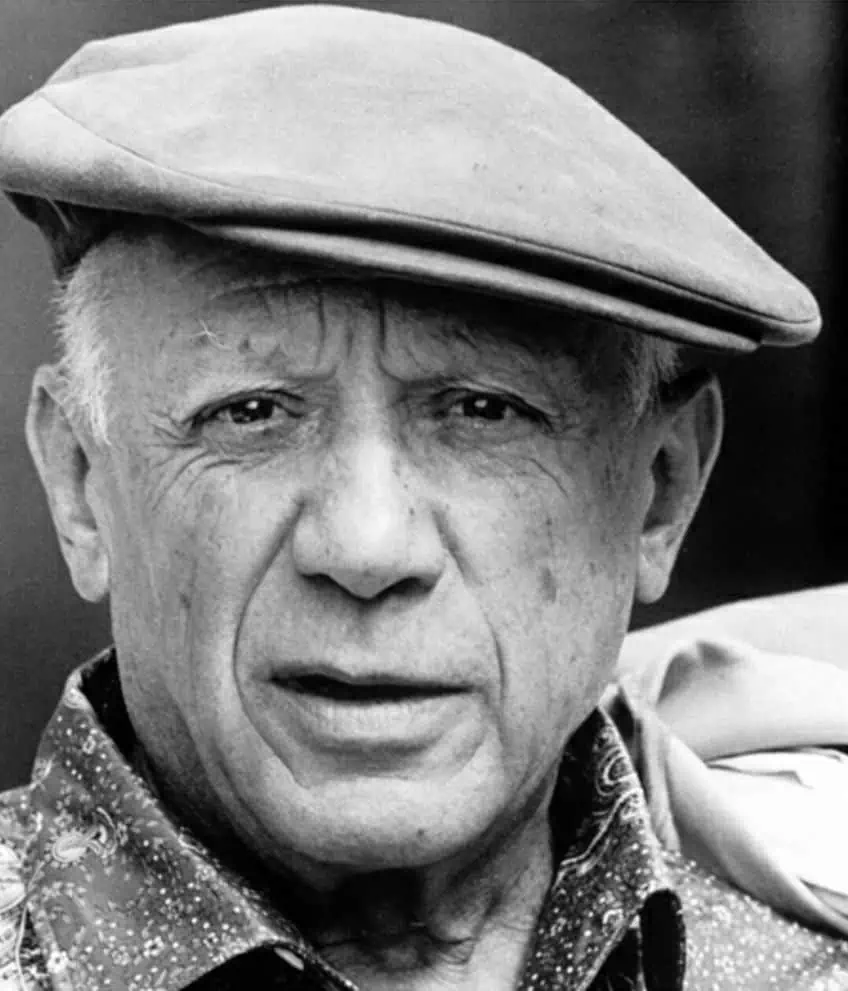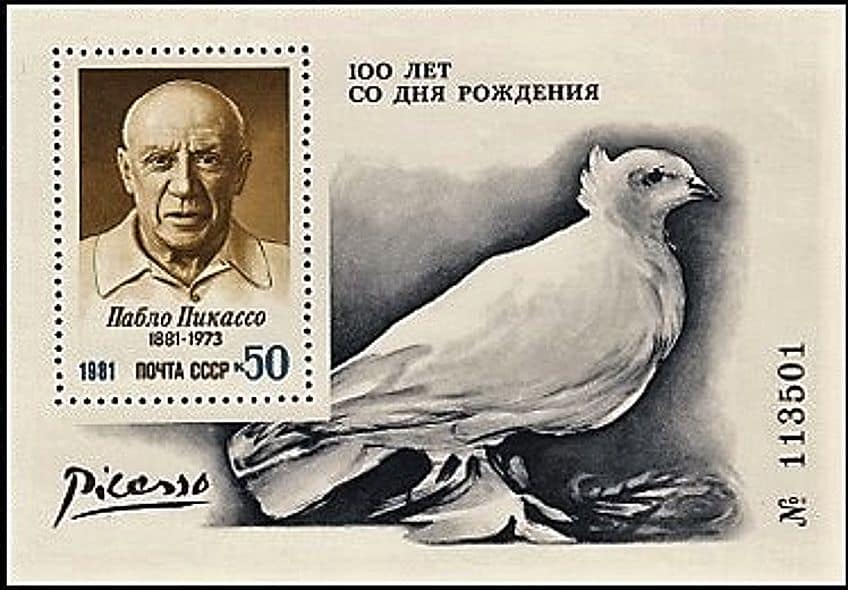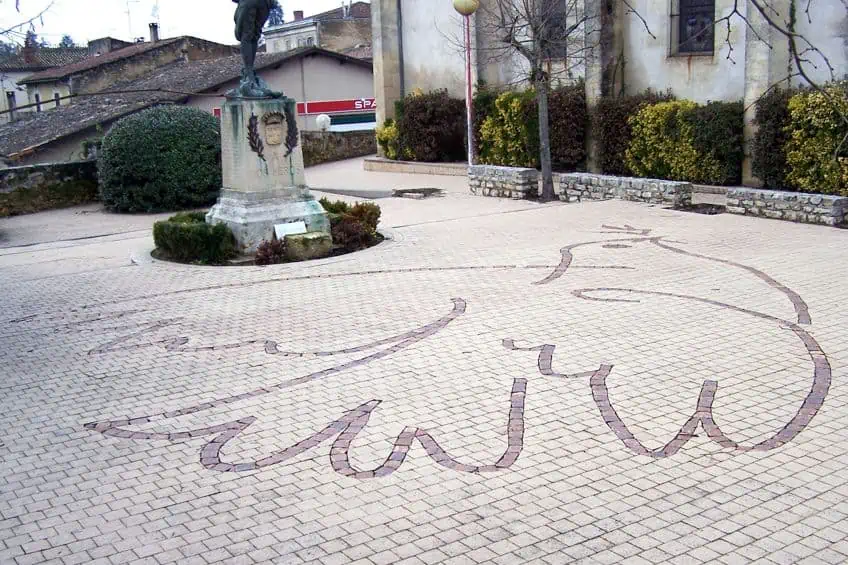“Dove of Peace” by Pablo Picasso – The Dove of Peace Analysis
Most people understand that an image of a white dove relates to world peace, but did you know that Pablo Picasso played a massive role in popularizing this global symbol? The image of a pigeon in mid-flight became an everlasting symbol of world peace after Picasso eternalized it in his illustration, Dove of Peace. In this article, we will complete a Dove of Peace analysis, as well as look at a few other Picasso artworks that evolved from this famous artwork.
Artist Abstract: Who Was Pablo Picasso?
Pablo Ruiz Picasso was a Spanish multimedia artist and is known for painting, sculpting, printmaking, pottery, and designing stages. Born in Malaga, Spain in 1881, he is widely regarded as one of the most significant artists of Modern Art. He co-founded the Cubist movement and produced groundbreaking works such as Les Demoiselles d’Avignon (1907) and Guernica (1937). Throughout his career, Picasso constantly experimented with new styles and techniques, which earned him a reputation as a revolutionary artist.
He passed away in 1973 at the age of 91, leaving behind a legacy of more than 50,000 works of art. His impact on the art world continues to influence generations of artists today.

Dove of Peace by Pablo Picasso in Context
| Date | 1949 |
| Medium | Illustration |
| Type of Artwork | Illustration and historical artwork |
| Movement | Cubism |
| Dimensions (cm) | 56.7 × 76 |
| Location | N/V |
Prior to the Spanish Civil War, Picasso was known to be politically indifferent, with his art dealer Daniel-Henry Kahnweiler describing him as the “most non-partisan individual” he had ever encountered. Nevertheless, the Spanish Civil War marked a turning point in Picasso’s perspective, leading him to become more politically aware and resulting in the creation of Guernica in 1937. The painting established Picasso as a symbol of anti-fascist sentiment.
By the conclusion of World War II, Picasso had joined the Communist Party, driven by his humanitarian convictions. To Picasso, Communism represented a distinct alternative that rejected both the fascism of the Spanish Civil War and World War II.
However, his affiliation with the party caused some degree of controversy. Over the period of 1948 to 1951, he took part in various World Peace Congresses. When asked to address the 1950 Peace Congress in Sheffield, Picasso declared, “I am on the side of life against death; I am on the side of peace against war.” The massive Guernica was created in response to the bombing of the Basque town of the same name during the Spanish Civil War by the Nazis. The chaotic and abstract composition conveys intense emotions that still resonate with viewers today and was widely recognized as a statement against war and fascism

Guernica, considered by many as one of the most impactful anti-war artworks globally, earned Picasso an invitation to create an image that symbolizes peace. His initial depiction of the Dove of Peace was chosen as the emblem for the Parisian conference in 1949. This initial design was a conventional, lifelike representation of a pigeon, gifted to him by his colleague and French artist Henri Matisse. Picasso later evolved this design into a minimalistic, stylized illustration, which has since become a universally recognized symbol of peace. As a testament to his connection to the image, he named his fourth child Paloma, the Spanish equivalent of ‘dove’.
The Dove of Peace became a recurring subject for Picasso and has become synonymous with world peace. It continues to be the emblem of the World Peace Council.
Dove of Peace Analysis
The painting is a stylized representation of a white dove in mid-flight. It is a simple, graphic line drawing with bold outlines, which gives the dove a powerful, immediate impact. The dove’s spread wings create a sense of motion and freedom as if it is soaring towards a new horizon.
This sense of upward movement is reinforced by the upward curves of the bird’s tail feathers, which echo the shape of its wings.

The white color of the dove is significant, as it symbolizes peace, purity, and hope. The simplicity of the image makes it instantly recognizable and memorable, reinforcing its powerful message. The use of black outlines gives the image a sense of graphic power, making it easily reproduced and widely distributed. Picasso’s choice of a dove as the symbol of peace was a deliberate one, as doves have a long-standing association with peace, love, and hope. Throughout history, doves have been depicted as messengers of peace, carrying messages from one place to another.
In this work, the dove carries the message of peace to the world, encouraging people to strive for a more peaceful future.
The First Dove Artwork Dove of Peace Analysis Continued
The illustration of the Dove of Peace discussed above was developed by Picasso from an initial lithograph he made – inspired by Matisse’s artwork. On January 9, 1949, Pablo Picasso created a black and white lithograph called Dove in the Parisian studio of printmaker Fernand Mourlot. Galerie Louise Leiris published the work in a limited edition of 5 artist proofs and 50 prints on white Arches wove paper.
The white dove depicted in the lithograph was created using ink wash and was a simple yet impactful image.
Mourlot referred to the work as “one of the most beautiful lithographs ever created” and praised its remarkable use of soft tones in the feathers. The Dove lithograph was used to create the poster for the 1949 Paris Peace Congress. Poet Louis Aragon, who was a supporter of the French Communist Party, chose the image after visiting Picasso’s studio.
The day before the congress opened on April 20, 1949, Picasso’s partner Françoise Gilot gave birth to their fourth child, whom they named Paloma, the Spanish word for dove.
More Dove Artworks by Picasso: Dove of Peace Analysis Continued
The image of the pigeon mid-flight evolved into two other works, Colombe Volant (Flying Dove) (1952) and Colombe au Soleil (Dove with Sun) (1962). These three works represent Picasso’s evolution as an artist and his changing views on peace. The first and realistic representation of the pigeon in Dove of Peace was a departure from Picasso’s earlier abstract works, but still held elements of his signature style, such as its simplicity and graphic quality.
In Colombe Volant (Flying Dove) (1952), Picasso returned to his more naturalistic style. The detailed feathering of the pigeon creates an illusion of effortless flight, and the bird’s mid-flight position with spread wings gives a sense of freedom and motion.

This work is much closer to the original illustration of the pigeon given to Picasso by Matisse and demonstrates the artist’s attention to naturalism. On the other hand, Colombe au Soleil (Dove with Sun) (1962) is an abstract representation of the dove, featuring a simple outline of the bird’s form. This work showcases Picasso’s exploration of the abstract, and its simple form conveys a sense of peace and stillness. The bird is also depicted in mid-flight with spread wings, providing a visual representation of freedom and movement.
In conclusion, Picasso’s Dove of Peace (1949) is a powerful image that speaks to the hopes and desires of humanity for peace. Its simplicity, bold lines, and graphic impact make it an enduring symbol of peace, inspiring generations to come. Through this work, Picasso has created an image that has become an integral part of our visual language, reminding us of the importance of working toward peace.
Frequently Asked Questions
Why Is Dove of Peace by Pablo Picasso So Special?
Dove of Peace (1949) by Pablo Picasso (1881 – 1973) is a significant piece of modern art, created in the aftermath of World War II. This first representation of the pigeon was a realistic illustration that Picasso created after receiving a traditional drawing of a pigeon from his friend and rival, Henri Matisse. It was chosen as the emblem for the First International Peace Conference in Paris, held in the same year. This work represents Picasso’s commitment to peace, as well as his stance against fascism and war. The white dove remains an iconic symbol of peace in art, with roots tracing back to Picasso’s vision. He chose this unassuming bird as a representation of world peace, as it brings to mind ideas of freedom and limitless possibilities.
How Did Pablo Picasso Develop the Symbol of Peace?
Pablo Picasso (1881 – 1973) created various versions of his dove design, with some more realistic and others more abstract. For example, Flying Dove (1952) is close to the original illustration, with its detailed and shaded feathers creating the illusion of effortless flight. On the other hand, Dove with Sun (1962) features a simple outline of a dove, showcasing the form with a sense of freedom and motion. The dove continued to be a theme in Picasso’s work after the completion of the assignment to create a symbol of peace.
Is Dove of Peace by Picasso a Symbol of Anti-Fascism?
Picasso’s artwork, including the Dove of Peace, reflects his political views, which became more pronounced after the Spanish Civil War. The Dove of Peace is seen as a symbol of anti-fascism and a rejection of the atrocities committed during the war.
Nicolene Burger, a South African multimedia artist and creative consultant, specializes in oil painting and performance art. She earned her BA in Visual Arts from Stellenbosch University in 2017. Nicolene’s artistic journey includes exhibitions in South Korea, participation in the 2019 ICA Live Art Workshop, and solo exhibitions. She is currently pursuing a practice-based master’s degree in theater and performance. Nicolene focuses on fostering sustainable creative practices and offers coaching sessions for fellow artists, emphasizing the profound communicative power of art for healing and connection. Nicolene writes blog posts on art history for artfilemagazine with a focus on famous artists and contemporary art.
Learn more about Nicolene Burger and about us.
Cite this Article
Nicolene, Burger, ““Dove of Peace” by Pablo Picasso – The Dove of Peace Analysis.” artfilemagazine – Your Online Art Source. April 4, 2023. URL: https://artfilemagazine.com/dove-of-peace-by-pablo-picasso/
Burger, N. (2023, 4 April). “Dove of Peace” by Pablo Picasso – The Dove of Peace Analysis. artfilemagazine – Your Online Art Source. https://artfilemagazine.com/dove-of-peace-by-pablo-picasso/
Burger, Nicolene. ““Dove of Peace” by Pablo Picasso – The Dove of Peace Analysis.” artfilemagazine – Your Online Art Source, April 4, 2023. https://artfilemagazine.com/dove-of-peace-by-pablo-picasso/.



